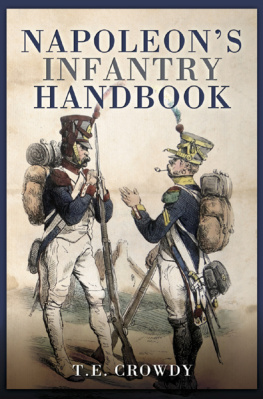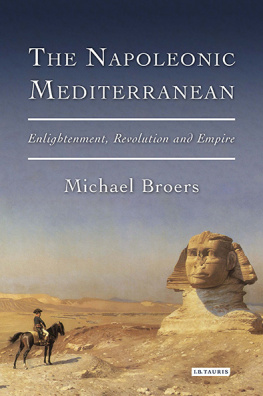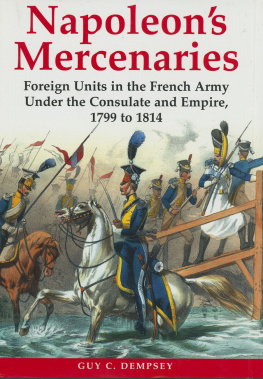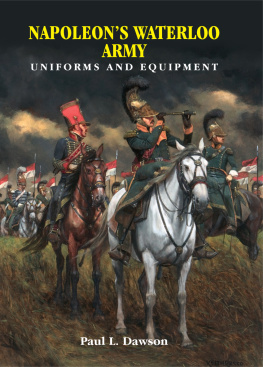First published in Great Britain in 2015 by
Pen & Sword Military
an imprint of
Pen & Sword Books Ltd
47 Church Street
Barnsley
South Yorkshire
S70 2AS
Copyright T.E. Crowdy 2015
ISBN: 978 1 78346 295 7
EPUB ISBN: 978 1 47385 232 7
PRC ISBN: 978 1 47385 238 9
The right of T.E. Crowdy to be identified as the Author of this Work has
been asserted by him in accordance with the Copyright, Designs and
Patents Act 1988.
A CIP catalogue record for this book is available from the British Library
All rights reserved. No part of this book may be reproduced or
transmitted in any form or by any means, electronic or mechanical
including photocopying, recording or by any information storage and
retrieval system, without permission from the Publisher in writing.
Typeset in Ehrhardt by
Mac Style Ltd, Bridlington, East Yorkshire
Printed and bound in the UK by CPI Group (UK) Ltd,
Croydon, CRO 4YY
Pen & Sword Books Ltd incorporates the imprints of Pen & Sword
Archaeology, Atlas, Aviation, Battleground, Discovery, Family History,
History, Maritime, Military, Naval, Politics, Railways, Select, Transport,
True Crime, and Fiction, Frontline Books, Leo Cooper, Praetorian Press,
Seaforth Publishing and Wharncliffe.
For a complete list of Pen & Sword titles please contact
PEN & SWORD BOOKS LIMITED
47 Church Street, Barnsley, South Yorkshire, S70 2AS, England
E-mail:
Website: www.pen-and-sword.co.uk
Contents
Tables
Diagrams
Anti-cavalry formations (1 August 1791)
I. Column of four battalions closed up with skirmishers deployed
II. Square of four battalions with artillery deployed |
Foreword
T wo hundred years on, the career of Napoleon Bonaparte, his Grande Arme, and his great adversaries continue to excite the imagination and evoke strong passions among historians and enthusiasts of military history. So much has been written about the Napoleonic wars, one would think the subject was all but exhausted; but no, the truth is we have hardly scratched the surface, particularly in the English speaking world. The Napoleonic Wars are rich in great battles, charismatic leaders, colourful uniforms, and these subjects naturally receive the greatest attention from authors and artists. However, two hundred years on, our world is so technologically and culturally removed from the one in which these men existed, how can we really understand what it was like to be a soldier for Napoleon? In a world without railways, radio, photography, or the understanding of something as basic as germs and the transmission of disease, how can we really connect with and understand their time?
There are numerous works by social historians who have studied the motivations and experiences of soldiers in the Napoleonic era, and these are important. However, having researched and written on the subject for a decade and a half, I realised there was still much to be said about the everyday habits and routines of Napoleons soldiers, and the mechanics which underpinned their experiences.
Under Napoleon alone, somewhere in the region of 2.4 million men were conscripted into the French Army. This is to say nothing of the emergency levies of the 1790s and the tens of thousands who served as National Guard Volunteers; but it gives an idea of the numbers of individual human beings who had experience of military service, who were processed, trained, uniformed and commanded by Napoleon and his marshals. In the English speaking world, much of our knowledge of this multitude originates from a handful of translated memoirs of infantrymen such as Captain Coignet, Sergeant Bourgogne and Captain Elzar Blaze. These memoirs are essential reading and are the mainstays of any Napoleonic collection, but they are the mere blink of an eye on a colossal subject. Take the memoirs of Blaze (a personal favourite). They tell of the absurdities of military life, the throwing away of useless articles of uniform, the practice of marauding, the pursuit of the fairer sex, the drinking of drams, the smoking of pipes and so on; but are they truly reflective of the experience of 2.4 million men? Even great memoirists such as Blaze ignore the basic practices and procedures they knew too well: what time they woke, how frequently they mounted guard, what the procedure was for applying for leave, or what time they went to bed. These memoirs were written for the amusement of fellow old soldiers initiated and steeped in the same rituals of army life as the author, and such pedantic attention to detail would hardly have excited cognitive function in their greying years. In short, they are incomplete as portraits of the soldierly daily life (vie quotidienne); so what hope have we of better understanding this subject?
Step forward Colonel tienne Alexandre Bardin (17741840). The son of a noted artist, Bardin served in one of the volunteer battalions of National Guardsmen raised after the storming of the Bastille in 1789. Intelligent and exact, Bardin quickly achieved the rank of adjutant major (a battalion-level staff officer) and bore witness to the opening battles of the war. He saw action at Hondschoote in 1793 and served in the Army of the Sambre and Meuse as a company commander in the 8th Light Infantry. He served in Italy and during the Consulate became an aide de camp to General Jean-Andoche Junot, who was, for a time, governor of Paris. For much of the imperial period, Bardin was attached to the ministry of war with the rank of major. In 1811 he held the rank of colonel with the regiment of Pupils of the Imperial Guard and then commanded the 9th Regiment of Tirailleurs of the Young Guard. After the disaster of Russia, Bardin saw active service in the Campaign of Saxony (1813) and was made a Baron of the Empire that same year. His military career concluded with an attachment to the War Depot, the forerunner of Frances military archives and historical service known today as the Service Historique de la Dfense. This brief biographical note is only given to establish Bardins credentials as a soldier, and to illustrate his exposure to the different elements of the armed services, operational and administrative. He also had a parallel career as an author of military reference books, and this is what makes him such an essential figure in our understanding of the Napoleonic military machine.
This book was largely inspired by the 1813 edition of Bardins Manuel de lInfanterie. This infantry manual was first published in 1807, but the 1813 edition really captures a high mark of the development of Frances infantry regiments; a process which began in the aftermath of the Seven Years War and which arguably came into real fruition during the period from the formation of the camp of Boulogne in 1804, until the British were driven out of Spain at Corunna in 1808. In this four year period, French infantry was unrivalled, besting the armies of Austria, Prussia, Russia, Spain and Britain in quick succession with only the occasional proverbial bloodied nose. Although in 1813 Napoleons empire was about to commence upon a cataclysmic decline, the technical and theoretical knowledge of soldiering codified in this small book was the bitter fruit of two decades of near continuous warfare. There were young men reading this book in 1813 who had not been born when the conflict heard its first shots in the summer of 1792. Although in 1812 Napoleon had lost an army in Russia, in the spring of 1813, it was not beyond the French nation to raise and equip a new army. Had the so-called Marie-Louise conscripts of 1813 been afforded a summer or two of peace in which to train and perfect their military education there is no reason to suppose they could not have been as formidable in war as their predecessors from the camp of Boulogne. Alas, Napoleons many enemies knew and feared this outcome and so refused to treat with the emperor. As a result the year 1813 was marked by the disasters of Vitoria in the south, and Leipzig in the east. Within two more summers the imperial army was dismembered and its eagles melted down for good.
Next page










